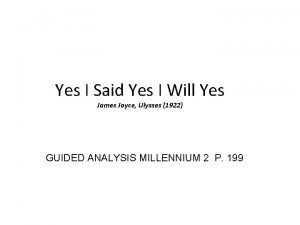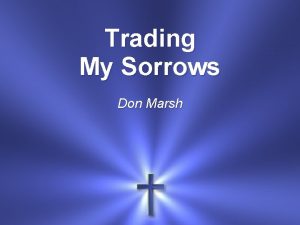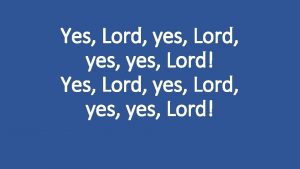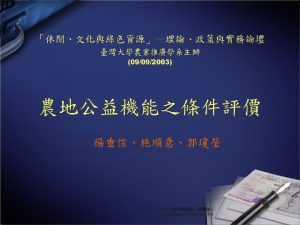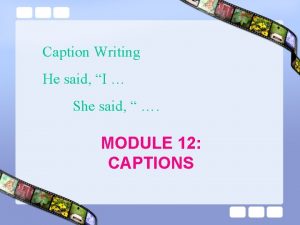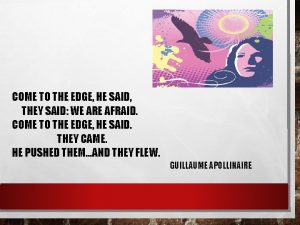Yes I Said Yes I Will Yes James






- Slides: 6

Yes I Said Yes I Will Yes James Joyce, Ulysses (1922) GUIDED ANALYSIS MILLENNIUM 2 P. 199

GUIDED ANALYSIS 1. Focus on the narrative technique. a. A good way to approach this unbroken flux of thoughts is to read the passage first silently then aloud, trying to give the right intonation by dividing it into small units. The beginning is given for you: • “The sun shines for you / he said the day we were lying among the rhododendrons on Howth head / in the grey tweed suit and his straw hat / the day I got him to propose / yes / first I gave him the bit of ” (ll. 1 – 3); • … first I gave him the bit of seedcake out of my mouth / • and it was leapyear / like now / yes / 16 years ago / my God / • after that long kiss I near lost my breath / yes / he said I was a flower of the mountain / yes / so we are flowers all / a womans body / yes / that was one true thing he said in his life / and the sun shines for you today / yes / … b. The repetition of the word “yes” works as a connector between sentences. Is its distribution regular? • The word “yes” is repeated mostly at the beginning and at the end of the passage, when Molly remembers how she made young Bloom propose to her. c. Is its use justified – in a narrative way – by any situation described in the passage ? • Its use is justified by the situation. Molly first remembers her saying “yes” to Leopold’s proposal.

d. now that you have entered Molly’s mind give line references to the following three main blocks of thoughts: memories of the day Bloom proposed to her § lines 1 – 10; § memories of her days in Gibraltar § lines 10 – 31; § the point when her Gibraltar lover and young Bloom merge § lines 32 - 36 e. The flowers, the mountains and the sea are recurrent images in Molly’s memories. Can we say that they link Molly’s memories in any way? § They are linked to Molly’s memories of love both in Ireland Gibraltar. In her memories the sea is either the North Sea or the Mediterranean; the flowers are the rhododendrons on Howth Head in Dublin Bay and the roses, jessamine and geraniums in Gibraltar

GUIDED SUMMARY 2. Using your answers to the questions above as a guideline, try to summarize the passage (maximum 150 words). • Molly’s thoughts run to the day when they were on Howth Head in Dublin Bay and she decided on young Leopold Bloom and made him propose to her. That day, among the rhododendrons, he called her a flower of the mountain and so he won her love and she gave him all the pleasure she could. • Then she started thinking of her past in Gibraltar, of which Bloom did not know anything, and of the beauty of the place and people there, where she had other kisses from other men. • In the end she decided that Bloom or another man was indifferent to her. So she embraced him pulling him down to her breast and noticed that his heart was beating fast, and finally she agreed to marry him. Her last words “yes I will Yes” represent the climax of both her stream of consciousness and her erotic fantasies.

WRITING NES 3. Consider the excerpts you have read analyse Joyce’s evolution in language and narrative technique from “Dubliners” to “Ulysses”. (maximum 260 words) • The style of “Dubliners” is complex: apparently, it is realistic in that it perfectly recreates characters, places, streets, pubs and idioms of contemporary Dublin. On the other hand, Joyce makes use of a subtle symbolic effect which gives the common objects unforeseen depth and becomes a key to a new, more conscious view of reality. In the excerpts from “The Dead” that we have read, we can see how Joyce’s style still reflects the naturalistic tradition; his prose in fact is made up of quite detailed organised sentences and of a well-expressed sense of time and place. The narrator’s detached objectivity which characterizes the other stories of “Dubliners” is here replaced by lyrical intensity and a more compassionate view of the people of Dublin. • “Ulysses” is one of the greatest examples of the reworking of myth in modernist literature: the adventures of the Homeric hero are used as a parallel to the events of common men and women in a day – June, 16, 1904 – in Dublin. The epic model, however, is used by Joyce to stress the lack of heroism, ideals, love and trust of the modern world.

WRITING NES 3. Consider the excerpts you have read analyse Joyce’s evolution in language and narrative technique from “Dubliners” to “Ulysses”. (maximum 260 words). • In both the excerpts from “Ulysses” we have read Joyce adopts the ‘stream-of-consciousness technique, but in Molly’s monologue it is taken to extremes, punctuation is completely abandoned, disparate and apparently incongruous images are juxtaposed in order to reproduce Molly’s process of thinking. The writer’s experimental technique is characterized by the use of incomplete sentences in an uninterrupted flow of thoughts, free associations and memories.
